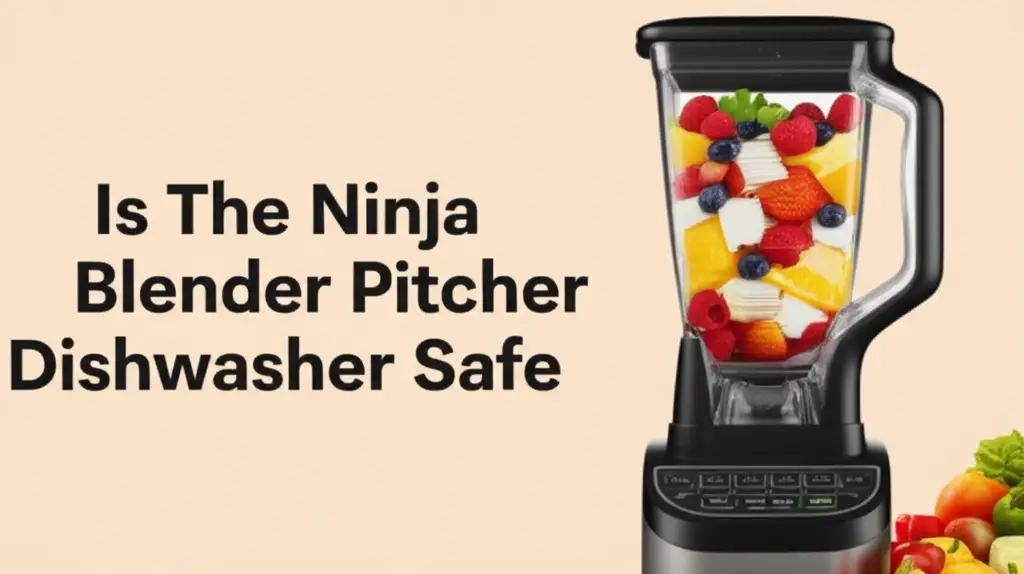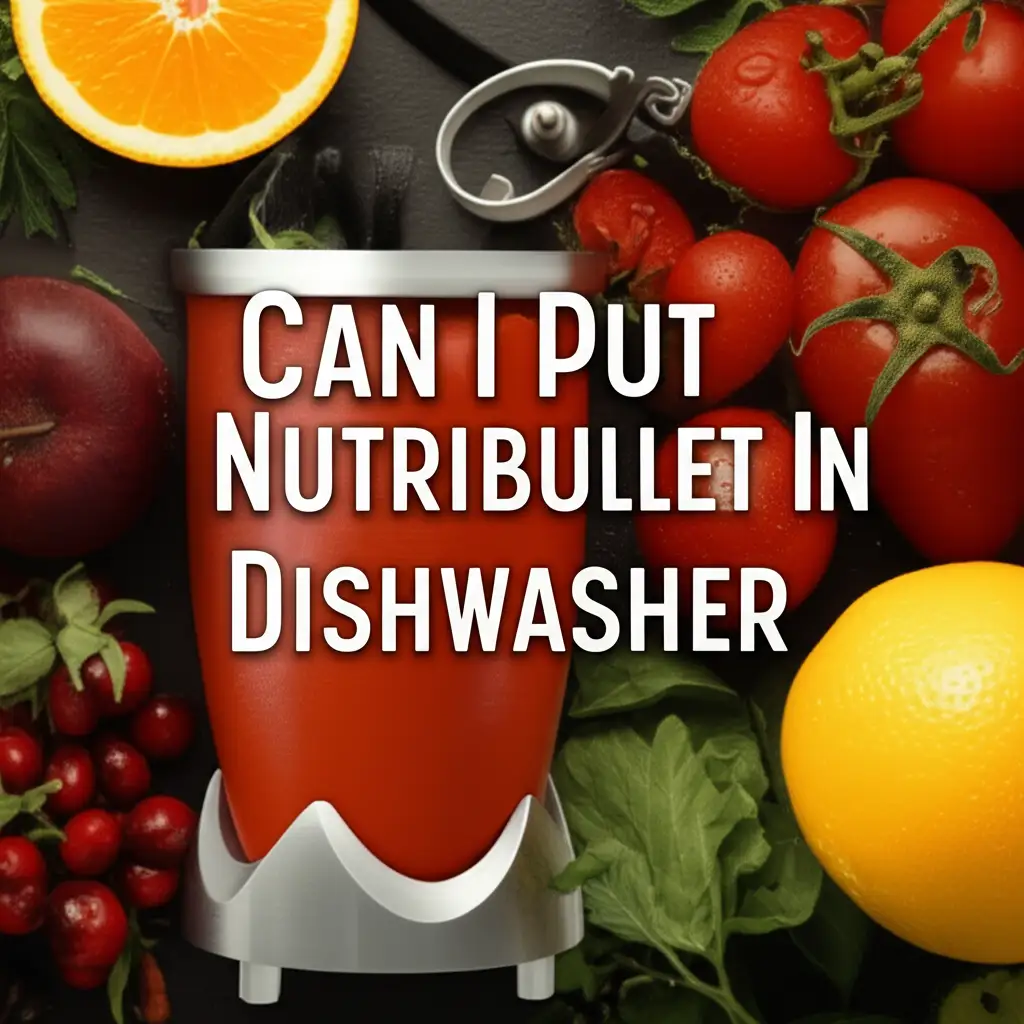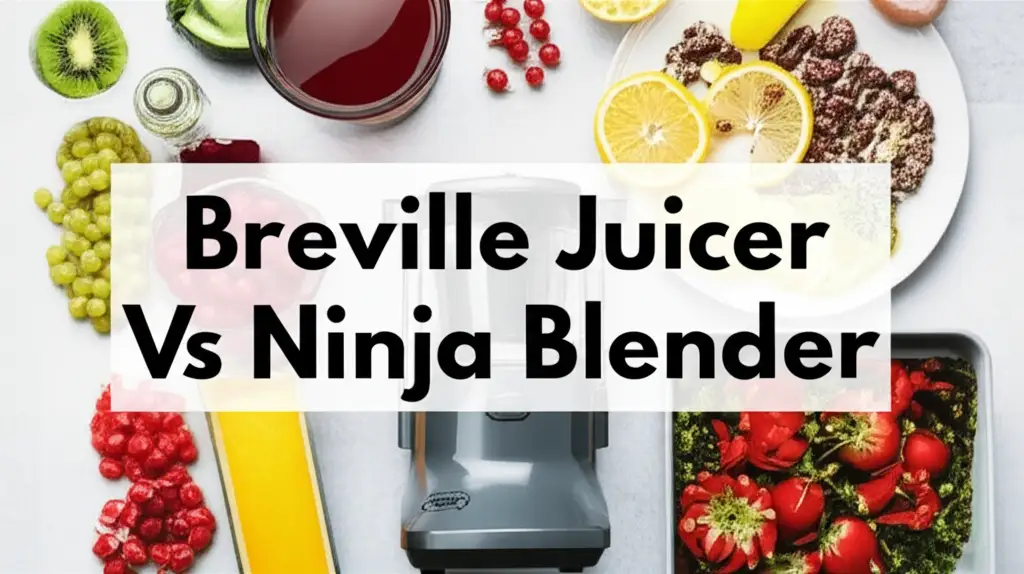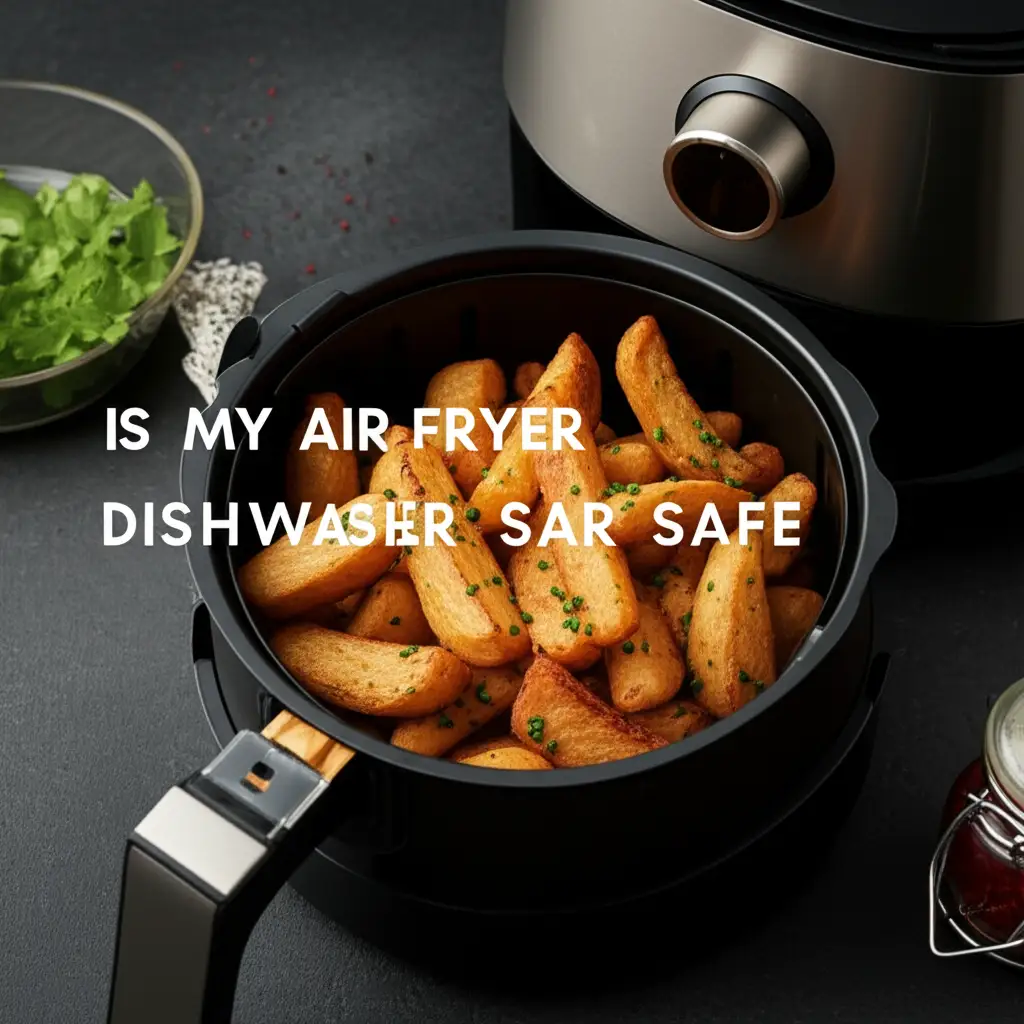· Elira Thomsen · Kitchen Appliances · 17 min read
Is The Ninja Blender Pitcher Dishwasher Safe

Is The Ninja Blender Pitcher Dishwasher Safe? Your Guide to Cleaning
Cleaning your blender after making a delicious smoothie or soup can feel like a chore. Many people wonder if their kitchen appliances can handle the convenience of a dishwasher. If you own a Ninja blender, you might ask, “Is the Ninja blender pitcher dishwasher safe?” This is a common question. You want to save time and ensure your blender lasts long. I have used many kitchen tools over the years. I know how important easy cleaning is. This article will help you understand if your Ninja blender pitcher is dishwasher safe. We will explore safe cleaning practices. We will also cover general care for your Ninja blender.
Takeaway
- Check Your Manual: Always refer to your specific Ninja blender model’s instruction manual for precise cleaning guidelines.
- Top Rack Recommended: Most Ninja blender pitchers are safe for the top rack of the dishwasher only.
- Low Heat Settings: Use low-heat or air-dry settings to prevent plastic distortion or clouding.
- Handwashing Benefits: Handwashing can prolong the life and clarity of your pitcher. It is often the safest method.
- Separate Blades: The sharp blade assembly should always be handled with care and removed before washing.
Yes, most Ninja blender pitchers are dishwasher safe. However, always place the pitcher on the top rack of your dishwasher. Use a gentle cycle and avoid high heat settings. This helps protect the plastic and extends the pitcher’s life. Always check your specific Ninja model’s user manual for the best cleaning advice.
Understanding Ninja Blender Pitcher Materials and Design
Ninja blender pitchers come in various designs. Most are made from durable, BPA-free plastic. Some high-end models might feature glass pitchers. The material of your pitcher directly affects its dishwasher safety. Plastic can warp or become cloudy with excessive heat. Glass is generally more heat-resistant.
Ninja designs its pitchers for powerful blending. They must withstand high forces. This design often includes thick walls and a strong base. These features help with durability during use. They also make the pitcher capable of handling cleaning. However, special care is still important. High temperatures in a dishwasher can degrade plastic over time. This leads to a cloudy appearance. It can also weaken the material. I always consider the material when cleaning any kitchen item. It ensures I keep my appliances looking new.
Many Ninja pitchers have integrated spouts or handles. These parts are part of the main mold. This design usually means fewer crevices for food to get stuck. It also means the entire pitcher can go in the dishwasher if safe. The robust nature of Ninja products often allows for machine washing. You should still be mindful of the heat. Too much heat can cause damage. Always think about what the pitcher is made from.
Ninja blades are extremely sharp. They are often made of stainless steel. The blade assembly usually sits separately from the pitcher. This design allows for thorough cleaning of both parts. The lid often has a sealing gasket. This gasket keeps liquids inside during blending. This gasket needs proper cleaning too. Understanding these parts helps you clean your entire Ninja system correctly. Knowing the materials helps you make smart cleaning choices.
General Dishwasher Safety Guidelines for Ninja Parts
When you put any appliance part in the dishwasher, general rules apply. This is true for your Ninja blender pitcher. High heat is the biggest enemy of many plastic items. Most dishwashers have different heat settings. You should choose a lower heat option. Some dishwashers also have an air-dry cycle. This is better than a heated dry cycle for plastic.
Always place your Ninja pitcher on the top rack. The top rack is further from the heating element. This reduces the risk of warping. Items on the bottom rack get more direct heat. This can be too intense for plastic pitchers. Make sure the pitcher is stable. It should not move around during the wash cycle. If it shifts, it might get damaged. It could also block the spray arms.
You should also use a gentle detergent. Harsh detergents contain strong chemicals. These chemicals can etch the surface of plastic over time. This etching makes the plastic look dull. It can also create tiny cracks. Look for mild dishwasher detergents. I always use a gentle soap for my plastic containers. It keeps them clear and smooth. This also applies to other kitchen items. For example, knowing if your air fryer is dishwasher safe also involves considering heat and detergent.
Before placing your pitcher in the dishwasher, rinse it. Remove any large food particles. This prevents clogs in your dishwasher filter. It also helps the dishwasher clean more effectively. Leftover food can bake onto the pitcher. This makes it harder to clean later. A quick rinse makes a big difference. It saves you from scrubbing stubborn stains.
Consider the other items in the dishwasher. Do not overload the dishwasher. Overloading prevents proper water circulation. This means some items may not get clean. It also increases the risk of items banging together. Such impacts can damage your pitcher. Give each item enough space for the water to reach it. This ensures a proper wash for all your kitchen items.
Specific Ninja Models: What the Manual Says
Ninja offers many blender models. Each model can have slight differences in its parts and materials. This means cleaning instructions can vary. For example, a Ninja Professional Blender 1000 watts might have different care needs than a Ninja Foodi Power Pitcher. Always check the specific user manual for your Ninja model. This is the most reliable source of information.
The manual will tell you exactly which parts are dishwasher safe. It will also specify if they are top-rack only. Some older Ninja models might have components that are not dishwasher safe at all. Modern Ninja models are generally designed for convenience. This includes being dishwasher friendly. However, never assume. Always verify the information in your manual. I keep my appliance manuals in a single folder. It makes finding cleaning instructions easy.
For instance, Ninja blenders often come with different blade assemblies. Some might be specifically marked for hand wash only. Others might be top-rack dishwasher safe. The same applies to different types of lids. Some lids have complex sealing mechanisms. These might need handwashing to prevent damage. Disassembling the lid into its separate parts for cleaning is often recommended. This ensures no food particles remain stuck.
If you cannot find your physical manual, most Ninja manuals are available online. Go to the Ninja Kitchen website. Search for your specific model number. You can usually download a PDF version. This provides the exact guidelines you need. Following these instructions helps maintain your warranty. It also ensures the longevity of your Ninja blender system. Many companies, like Ninja, design their products for a long life. Proper care, as outlined in their manuals, is key to achieving this.
Remember that a pitcher from one Ninja system might not be interchangeable with another. This also applies to their cleaning methods. For example, a Ninja Air Fryer basket has specific cleaning needs. These are different from a blender pitcher. Each Ninja product is unique. Treat each part according to its specific design and material.
Benefits of Handwashing Your Ninja Pitcher
While many Ninja blender pitchers are dishwasher safe, handwashing offers several benefits. Handwashing gives you more control. You can use gentler water temperatures. You can also use milder soap. This helps preserve the clarity and integrity of plastic pitchers. Over time, repeated high heat cycles in a dishwasher can cause plastic to become cloudy. This is known as “etching” or “hazing.” Handwashing prevents this.
Handwashing also helps protect internal components. The blades are extremely sharp. They can damage other items in the dishwasher if not secured. They can also get dulled faster in a dishwasher. Handwashing allows you to clean around the blades carefully. You can use a brush to reach all crevices. This ensures no food residue remains. I always handwash my blades immediately after use. This makes cleaning easier and safer.
To handwash your Ninja pitcher:
- Rinse Immediately: Right after use, rinse the pitcher with warm water. This prevents food from drying and sticking.
- Add Soap and Water: Fill the pitcher halfway with warm water. Add a drop or two of dish soap.
- Blend (Optional): For quick cleaning, place the pitcher back on the base. Run the blender for 10-20 seconds. This self-cleans the blades and walls.
- Scrub Gently: Use a soft sponge or bottle brush. Scrub the inside walls of the pitcher. Pay attention to the corners.
- Clean Blades Carefully: Remove the blade assembly. Wash it under running water. Use a brush to clean around the blades. Be extremely careful not to touch the sharp edges. I always hold the blade assembly by its plastic base. This keeps my fingers safe.
- Wash the Lid: Disassemble the lid if possible. Wash all parts with soap and water. Pay attention to the gasket.
- Rinse Thoroughly: Rinse all parts until no soap residue remains.
- Air Dry: Place all parts upside down on a drying rack. Allow them to air dry completely. This prevents water spots and mildew.
Handwashing ensures a deep clean for all parts. It helps you inspect for any wear or damage. This routine can extend the life of your Ninja blender significantly. It keeps your pitcher looking clear and new. It also reduces the chance of food residue building up. This is especially true if you are blending sticky or thick ingredients often.
Common Pitfalls: What to Avoid When Dishwashing Ninja Parts
Even if your Ninja pitcher is dishwasher safe, there are things to avoid. These pitfalls can shorten the life of your pitcher. They can also affect its appearance. Knowing these common mistakes helps you clean your blender correctly. I have learned these lessons over time. Avoiding them saves trouble.
First, high heat cycles are a major problem. Dishwashers often have “sanitize” or “heavy duty” settings. These settings use very hot water and high heat for drying. While good for sterilizing dishes, they are too harsh for most plastic blender pitchers. High heat can cause plastic to warp. It can also make it brittle. The plastic may develop a cloudy film. This film is hard to remove. Always choose a lower temperature setting. Opt for an air-dry option if available.
Second, placing items on the bottom rack is a common error. As mentioned, the bottom rack is closer to the heating element. This area receives much more intense heat. Plastic pitchers placed here are at high risk of melting or deforming. Always use the top rack only. This rule applies to most plastic kitchenware. It protects your items from excessive heat exposure.
Third, harsh detergents and abrasive cleaners can damage your pitcher. Some dishwasher detergents contain strong chemicals or abrasives. These can scratch or dull the plastic surface. They can also strip away protective coatings. Avoid powdered detergents that may not dissolve fully. These can leave a residue. Stick to liquid or gel detergents. Choose ones that are gentle on plastics. Using the right kind of cleaner is important. This is similar to choosing safe cleaners for stainless steel mixing bowls or other specific kitchenware.
Fourth, improper loading can lead to issues. Do not cram your pitcher into a tight spot. Ensure water spray can reach all surfaces. If the pitcher is blocked, it won’t get clean. It might also bang against other dishes. This can cause cracks or chips. Give it enough room. Secure it so it doesn’t flip over. This ensures a proper wash and prevents damage.
Fifth, washing parts that are not designed for the dishwasher is a big mistake. The blender base, for example, contains electrical components. It should never go into the dishwasher. Always wipe it clean with a damp cloth. Also, some specialized Ninja accessories might be hand-wash only. Check the manual for each specific part. This prevents damage and keeps your warranty valid. Avoiding these common mistakes helps your Ninja pitcher stay in excellent condition for years.
Beyond the Pitcher: Cleaning Other Ninja Blender Components
Cleaning your Ninja blender involves more than just the pitcher. Each component requires specific care. Proper cleaning of all parts ensures hygiene. It also keeps your blender working effectively. I always clean all parts thoroughly after each use.
The Blade Assembly
The blade assembly is the most critical part for safety. Ninja blades are extremely sharp. They can cause serious cuts. Never put your hand directly into the pitcher to remove or clean the blades. Always remove the blade assembly first. Many Ninja blade assemblies are marked as dishwasher safe (top rack). However, handwashing is often safer.
To handwash the blades:
- Rinse them immediately after use to prevent food from drying.
- Use a brush with a handle to scrub around the blades. Do not use your fingers.
- Hold the assembly by its plastic base, away from the sharp edges.
- Rinse thoroughly and air dry. This prevents rust on the metal parts.
The Lid and Gasket
Ninja blender lids usually have a sealing gasket. This gasket prevents leaks during blending. Food particles can get trapped under the gasket. This can lead to odors or mold growth. Most Ninja lids are dishwasher safe (top rack). However, it’s best to take them apart if possible.
To clean the lid:
- Disassemble any removable parts from the lid.
- Remove the gasket. Wash it separately with warm soapy water.
- Wash the lid parts by hand or on the top rack of the dishwasher.
- Ensure all parts are completely dry before reassembling. This stops mildew.
The Blender Base
The blender base holds the motor and electrical wiring. The blender base is NEVER dishwasher safe. Do not immerse it in water. Do not rinse it under a faucet. Getting the base wet can damage the motor. It can also create an electrical hazard.
To clean the blender base:
- Unplug the blender from the power outlet. This is a crucial safety step.
- Wipe the exterior of the base with a damp cloth.
- Use a soft brush or a dry cloth to clean any food debris from the motor coupling area.
- Do not use abrasive cleaners. They can scratch the finish.
- Ensure the base is completely dry before plugging it back in or using it.
Taking care of all these parts properly ensures your Ninja blender remains clean. It also ensures it stays functional. A well-maintained blender is safer to use. It also performs better for longer. This comprehensive approach to cleaning helps maintain your kitchen investment.
Troubleshooting Common Ninja Pitcher Cleaning Issues
Sometimes, despite your best efforts, you might encounter cleaning challenges with your Ninja pitcher. These issues are common. They usually have simple solutions. I have dealt with these many times myself.
Stains and Discoloration
Plastic pitchers can develop stains from colorful foods. Berries, turmeric, or carrots are common culprits. These can leave a yellow or orange tint.
- Solution 1: Lemon Juice and Sunlight: After cleaning, rub a cut lemon on the stained areas. Let the pitcher sit in direct sunlight for a few hours. The sun’s UV rays and the lemon’s acid help bleach out the stains naturally.
- Solution 2: Baking Soda Paste: Mix baking soda with a little water to form a paste. Apply the paste to the stains. Let it sit for 30 minutes to an hour. Then scrub gently with a soft sponge and rinse. Baking soda is a gentle abrasive. It helps lift stains without scratching.
- Solution 3: Dishwasher Detergent Soak: Fill the pitcher with warm water. Add a tablespoon of dishwasher detergent. Let it soak overnight. Then wash as usual. This can help break down stubborn stains.
Lingering Odors
Sometimes, strong-smelling ingredients like garlic or onion can leave an odor. This smell can linger in plastic pitchers.
- Solution 1: Baking Soda Soak: Fill the pitcher with warm water. Add a few tablespoons of baking soda. Let it soak overnight. Baking soda absorbs odors. Rinse thoroughly in the morning.
- Solution 2: Vinegar Rinse: After washing, rinse the pitcher with a solution of equal parts white vinegar and water. Let it sit for a few minutes. Then rinse with plain water. Vinegar neutralizes odors.
- Solution 3: Lemon Peel and Water Blend: Put a few lemon peels and some water in the pitcher. Blend for a few seconds. This can freshen the pitcher naturally. Dispose of the contents. Then wash as usual.
Cloudy Plastic (Hazing)
Cloudiness usually results from hard water mineral deposits or high heat exposure.
- Solution 1: White Vinegar Treatment: Fill the pitcher with equal parts white vinegar and water. Let it sit for a few hours or overnight. Vinegar helps dissolve mineral deposits. Rinse well afterward.
- Solution 2: Avoid High Heat: To prevent future cloudiness, always use the top rack of the dishwasher. Also, use low heat or air-dry settings. Handwashing is the best way to maintain clarity over time. This is also important for other plastic items. For example, understanding if BPA-free means dishwasher safe often involves considerations about heat sensitivity.
These tips can help keep your Ninja pitcher clean and clear. Regular and proper cleaning extends the life and look of your blender. It ensures your blender is ready for your next healthy creation.
FAQ Section
Are Ninja blades dishwasher safe?
Most Ninja blade assemblies are top-rack dishwasher safe. However, due to their extreme sharpness, handwashing is often recommended for safety. Always handle blades with great care. Use a long-handled brush for cleaning. Never touch the sharp edges directly with your hands.
Can I put Ninja blender cups in the dishwasher?
Yes, most individual Ninja blender cups (like single-serve cups) are dishwasher safe. Just like the larger pitcher, place them on the top rack. Use a low-heat setting for drying. Check your specific Ninja model’s manual to confirm the dishwasher safety of its cups.
How to remove stains from Ninja pitcher?
For stains from colorful foods, try a baking soda paste. Mix baking soda with water, apply to stains, let sit, then scrub gently. You can also rub a cut lemon on the stains and let the pitcher sit in sunlight. Soaking with diluted white vinegar can also help lift stubborn stains.
Is Ninja blender base waterproof?
No, the Ninja blender base is not waterproof. It contains the motor and electrical components. Never immerse the base in water or place it in the dishwasher. Clean the blender base by wiping its exterior with a damp cloth. Always unplug it before cleaning.
What temperature water for washing Ninja pitcher?
When handwashing, use warm, soapy water. If using a dishwasher, select a low-temperature wash cycle. Avoid high heat or sanitize settings. High heat can cause plastic pitchers to warp, crack, or become cloudy over time. An air-dry or no-heat dry option is best.
Can I use any dishwasher liquid in my dishwasher for Ninja parts?
It’s best to use a mild, gentle dishwasher detergent. Avoid harsh detergents with strong chemicals or abrasive components. These can scratch or dull the plastic surface of your Ninja pitcher over time. For general dishwasher use, consider if you can use specific dishwasher liquid based on the material being washed.
Conclusion
Keeping your Ninja blender clean is important. It ensures hygiene and extends the life of your appliance. Most Ninja blender pitchers are indeed dishwasher safe. You must place them on the top rack. You should also use low heat settings. This prevents damage and maintains the pitcher’s clarity. Always consult your specific model’s manual for the most accurate care instructions.
Handwashing offers extra protection. It gives you control over water temperature and soap. This helps avoid cloudiness and wear. Remember to clean all parts: the pitcher, the sharp blades, the lid, and the base. The base is never dishwasher safe. By following these simple cleaning guidelines, your Ninja blender pitcher will stay clean. It will perform well for many years. Proper care makes a big difference. Enjoy blending your favorite recipes with a clean and ready Ninja blender!





